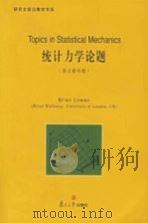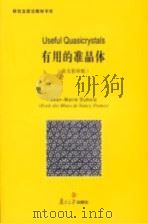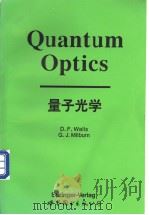《统计力学论题 英文影印版》
| 作者 | (英)Brian Cowan著 编者 |
|---|---|
| 出版 | 上海:复旦大学出版社 |
| 参考页数 | 319 |
| 出版时间 | 没有确切时间的资料 目录预览 |
| ISBN号 | 无 — 求助条款 |
| PDF编号 | 817681338(仅供预览,未存储实际文件) |
| 求助格式 | 扫描PDF(若分多册发行,每次仅能受理1册) |

1The Methodology of Statistical Mechanics1
1.1Terminology and Methodology1
1.1.1 Approaches to the subject1
1.1.2 Description of states3
1.1.3 Extensivity and the thermodynamic limit3
1.2The Fundamental Principles4
1.2.1 The laws of thermodynamics4
1.2.2 Probabilistic interpretation of the First Law6
1.2.3 Microscopic basis for entropy7
1.3Interactions—The Conditions for Equilibrium8
1.3.1 Thermal interaction—Temperature8
1.3.2 Volume change—Pressure10
1.3.3 Particle interchange—Chemical potential12
1.3.4 Thermal interaction with the rest of the world—The Boltzmann factor13
1.3.5 Particle and energy exchange with the rest of the world—The Gibbs factor15
1.4Thermodynamic Averages17
1.4.1 The partition function17
1.4.2 Generalised expression for entropy18
1.4.3 Free energy20
1.4.4 Thermodynamic variables21
1.4.5 Fluctuations21
1.4.6 The grand partition function23
1.4.7 The grand potential24
1.4.8 Thermodynamic variables25
1.5Quantum Distributions25
1.5.1 Bosons and fermions25
1.5.2 Grand potential for identical particles28
1.5.3 The Fermi distribution29
1.5.4 The Bose distribution30
1.5.5 The classical limit—The Maxwell distribution30
1.6Classical Statistical Mechanics31
1.6.1 Phase space and classical states31
1.6.2 Boltzmann and Gibbs phase spaces33
1.6.3 The Fundamental Postulate in the classical case34
1.6.4 The classical partition function35
1.6.5 The equipartition theorem35
1.6.6 Consequences of equipartition37
1.6.7 Liouville's theorem38
1.6.8 Boltzmann's H theorem40
1.7The Third Law of Thermodynamics42
1.7.1 History of the Third Law42
1.7.2 Entropy43
1.7.3 Quantum viewpoint44
1.7.4 Unattainability of absolute zero46
1.7.5 Heat capacity at low temperatures46
1.7.6 Other consequences of the Third Law48
1.7.7 Pessimist's statement of the laws of thermodynamics50
2Practical Calculations with Ideal Systems54
2.1The Density of States54
2.1.1 Non-interacting systems54
2.1.2 Converting sums to integrals54
2.1.3 Enumeration of states55
2.1.4 Counting states56
2.1.5 General expression for the density of states58
2.1.6 General relation between pressure and energy59
2.2Identical Particles61
2.2.1 Indistinguishability61
2.2.2 Classical approximation62
2.3Ideal Classical Gas62
2.3.1 Quantum approach62
2.3.2 Classical approach64
2.3.3 Thermodynamic properties64
2.3.4 The 1/N!term in the partition function66
2.3.5 Entropy of mixing67
2.4Ideal Fermi Gas69
2.4.0 Methodology for quantum gases69
2.4.1 Fermi gas at zero temperature70
2.4.2 Fermi gas at low temperatures—simple model72
2.4.3 Fermi gas at low temperatures—series expansion75
Chemical potential78
Internal energy80
Thermal capacity81
2.4.4 More general treatment of low temperature heat capacity81
2.4.5 High temperature behaviour—the classical limit84
2.5Ideal Bose Gas87
2.5.1 General procedure for treating the Bose gas87
2.5.2 Number of particles—chemical potential88
2.5.3 Low temperature behaviour of Bose gas89
2.5.4 Thermal capacity of Bose gas—below Tc91
2.5.5 Comparison with superfluid 4He and other systems93
2.5.6 Two-fluid model of superfluid 4He95
2.5.7 Elementary excitations96
2.6Black Body Radiation—The Photon Gas98
2.6.1 Photons as quantised electromagnetic waves98
2.6.2 Photons in thermal equilibrium—black body radiation99
2.6.3 Planck's formula100
2.6.4 Internal energy and heat capacity102
2.6.5 Black body radiation in one dimension103
2.7Ideal Paramagnet105
2.7.1 Partition function and free energy105
2.7.2 Thermodynamic properties106
2.7.3 Negative temperatures110
2.7.4 Thermodynamics of negative temperatures112
3Non-Ideal Gases120
3.1Statistical Mechanics120
3.1.1 The partition function120
3.1.2 Cluster expansion121
3.1.3 Low density approximation122
3.1.4 Equation of state123
3.2The Virial Expansion124
3.2.1 Virial coefficients124
3.2.2 Hard core potential124
3.2.3 Square-well potential126
3.2.4 Lennard-Jones potential127
3.2.5 Second virial coefficient for Bose and Fermi gas130
3.3Thermodynamics130
3.3.1 Throttling130
3.3.2 Joule-Thomson coefficient131
3.3.3 Connection with the second virial coefficient132
3.3.4 Inversion temperature134
3.4Van der Waals Equation of State134
3.4.1 Approximating the partition function134
3.4.2 Van der Waals equation135
3.4.3 Microscopic"derivation"of parameters137
3.4.4 Virial expansion138
3.5Other Phenomenological Equations of State139
3.5.1 The Dieterici equation139
3.5.2 Virial expansion139
3.5.3 The Berthelot equation140
4Phase Transitions143
4.1Phenomenology143
4.1.1 Basic ideas143
4.1.2 Phase diagrams145
4.1.3 Symmetry147
4.1.4 Order of phase transitions148
4.1.5 The order parameter149
4.1.6 Conserved and non-conserved order parameters151
4.1.7 Critical exponents152
4.1.8 Scaling theory154
4.1.9 Scaling of the free energy158
4.2First-Order Transition—An Example159
4.2.1 Coexistence159
4.2.2 Van der Waals fluid162
4.2.3 The Maxwell construction163
4.2.4 The critical point165
4.2.5 Corresponding states166
4.2.6 Dieterici's equation168
4.2.7 Quantum mechanical effects169
4.3Second-Order Transition—An Example170
4.3.1 The ferromagnet170
4.3.2 The Weiss model172
4.3.3 Spontaneous magnetisation173
4.3.4 Critical behaviour176
4.3.5 Magnetic susceptibility177
4.3.6 Goldstone modes178
4.4The Ising and Other Models180
4.4.1 Ubiquity of the Ising model180
4.4.2 Magnetic case of the Ising model182
4.4.3 Ising model in one dimension184
4.4.4 Ising model in two dimensions185
4.4.5 Mean field critical exponents188
4.4.6 The XY model190
4.4.7 The spherical model191
4.5Landau Treatment of Phase Transitions191
4.5.1 Landau free energy191
4.5.2 Landau free energy for the ferromagnet193
4.5.3 Landau theory—second-order transitions196
4.5.4 Thermal capacity in the Landau model198
4.5.5 Ferromagnet in a magnetic field199
4.6Ferroelectricity201
4.6.1 Description of the phenomenon201
4.6.2 Landau free energy202
4.6.3 Second-order case203
4.6.4 First-order case204
4.6.5 Entropy and latent heat at the transition208
4.6.6 Soft modes209
4.7Binary Mixtures210
4.7.1 Basic ideas210
4.7.2 Model calculation211
4.7.3 System energy212
4.7.4 Entropy213
4.7.5 Free energy214
4.7.6 Phase separation—the lever rule215
4.7.7 Phase separation curve—the binodal217
4.7.8 The spinodal curve219
4.7.9 Entropy in the ordered phase220
4.7.10 Thermal capacity in the ordered phase222
4.7.11 Order of the transition and the critical point223
4.7.12 The critical exponentβ225
4.8Quantum Phase Transitions226
4.8.1 Introduction226
4.8.2 The transverse Ising model228
4.8.3 Revision of mean field Ising model228
4.8.4 Application of a transverse field230
4.8.5 Transition temperature232
4.8.6 Quantum critical behaviour233
4.8.7 Dimensionality and critical exponents234
4.9Retrospective236
4.9.1 The existence of order236
4.9.2 Validity of mean field theory237
4.9.3 Features of different phase transition models238
5Fluctuations and Dynamics243
5.1Fluctuations244
5.1.1 Probability distribution functions244
5.1.2 Mean behaviour of fluctuations246
5.1.3 The autocorrelation function250
5.1.4 The correlation time253
5.2Brownian Motion254
5.2.1 Kinematics of a Brownian particle255
5.2.2 Short time limit257
5.2.3 Long time limit258
5.3Langevin's Equation260
5.3.1 Introduction260
5.3.2 Separation of forces261
5.3.3 The Langevin equation263
5.3.4 Mean square velocity and equipartition264
5.3.5 Velocity autocorrelation function265
5.3.6 Electrical analogue of the Langevin equation267
5.4Linear Response—Phenomenology268
5.4.1 Definitions268
5.4.2 Response to a sinusoidal excitation270
5.4.3 Fourier representation271
5.4.4 Response to a step excitation272
5.4.5 Response to a delta function excitation273
5.4.6 Consequence of the reality of X(t)274
5.4.7 Consequence of causality275
5.4.8 Energy considerations277
5.4.9 Static susceptibility278
5.4.10 Relaxation time approximation280
5.5Linear Response—Microscopics281
5.5.1 Onsager's hypothesis281
5.5.2 Nyquist's theorem283
5.5.3 Calculation of the step response function285
5.5.4 Calculation of the autocorrelation function286
Appendixes291
Appendix 1The Gibbs-Duhem Relation291
A.1.1 Homogeneity of the fundamental relation291
A.1.2 The Euler relation291
A.1.3 A caveat292
A.1.4 The Gibbs-Duhem relation292
Appendix 2Thermodynamic Potentials293
A.2.1 Equilibrium states293
A.2.2 Constant temperature(and volume):the Helmholtz potential295
A.2.3 Constant pressure and energy:the Enthalpy function296
A.2.4 Constant pressure and temperature:the Gibbs free energy296
A.2.5 Differential expressions for the potentials297
A.2.6 Natural variables and the Maxwell relations298
Appendix 3Mathematica Notebooks299
A.3.1 Chemical potential of Fermi gas at low temperatures299
A.3.2 Internal energy of the Fermi gas at low temperatures301
A.3.3 Fugacity of the ideal gas at high temperatures—Fermi,Maxwell and Bose cases303
A.3.4 Internal energy of the ideal gas at high temperatures—Fermi,Maxwell and Bose cases307
Appendix 4Evaluation of the Correlation Function Integral310
A.4.1 Initial domain of integration310
A.4.2 Transformation of variables310
A.4.3 Jacobian of the transformation311
Index313
《统计力学论题 英文影印版》由于是年代较久的资料都绝版了,几乎不可能购买到实物。如果大家为了学习确实需要,可向博主求助其电子版PDF文件(由(英)Brian Cowan著 上海:复旦大学出版社 出版的版本) 。对合法合规的求助,我会当即受理并将下载地址发送给你。
高度相关资料
-

- 生物化学 影印版
- 1999 北京:科学出版社
-

- 遗传学 影印版
- 1999
-

- 破戒.影印版
- 1954.12 新潮社
-

- 玻璃质材料和无序固体 它们的统计力学导论 英文影印版
- 上海:复旦大学出版社
-

- 加速器物理学 第2版 英文影印版
- 上海:复旦大学出版社
-

- 有用的准晶体 英文影印版
- 上海:复旦大学出版社
-

- 电子学 第2版 影印版
- 1989 清华大学出版社,Cambridge University Press
-

- 财务会计教程 英文影印
- 1998 华夏出版社
-

- 生态学 第3版·影印版
- 1999 科学出版社
-

- 量子光学 英文影印版
- 1998 世界图书出版公司北京公司
提示:百度云已更名为百度网盘(百度盘),天翼云盘、微盘下载地址……暂未提供。➥ PDF文字可复制化或转WORD




